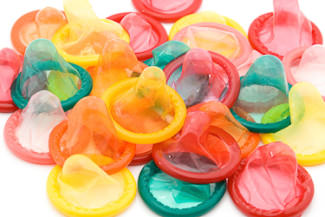 I don't know anyone who really likes condoms except for me! I consider them a sign of my personal independence, my ability to protect myself. Condoms allow me to be the slut I enjoy being. I carry them almost every time I go out, because I like the naughty feeling of being a married girl with a condom in her coat pocket or purse.
I don't know anyone who really likes condoms except for me! I consider them a sign of my personal independence, my ability to protect myself. Condoms allow me to be the slut I enjoy being. I carry them almost every time I go out, because I like the naughty feeling of being a married girl with a condom in her coat pocket or purse.
In this article I am going to discuss the effectiveness of condoms for the prevention of STD's, plus hints and tips. Please add your condom questions, suggestions or experiences in the comment section.
I hear all the time, “Condoms aren't 100%, so why bother at all?” I'm going to give you the statistics and hopefully you'll agree with me that the protection they do offer is worth it. Just like a seat belt won't prevent every fatality, they do prevent a significant number of deaths and injuries.
STD's fall into different categories. Some are transmitted through fluids like blood, semen and vaginal fluid. Some are skin to skin. I am going to be following up with articles about specific STD's, so you'll learn more about them through this series. Condoms are very effective for preventing fluid transmission type infections. They are less effective for skin to skin diseases because a condom only covers the cock, not the whole lower body. Less effective doesn't mean not effective though. All STD organisms are too small to pass through a latex or poly- urethane barrier.
These studies are based on transmission by vaginal intercourse between heterosexual couples. Oral sex is a lower risk activity, anal sex is higher risk. I will explain this further in future postings.
Scientists believe condoms may actually be more effective than studies indicate. This is because some people lie about condom use because they feel that is what they should say and because some people don't use condoms properly.
HIV – Condoms are awesome for prevention of HIV, the virus that causes AIDs. Most recent studies indicate that they are 95% effective.
Chlamydia – Transmission is significantly reduced by using condoms. In a study of people with partners who had Chlamydia 13% of condom users were infected vs. 34% of non-users. This is about a 60% reduction. As you see, some condom users still contracted the infection or had the infection without symptoms before the study began. That is why if you are exposed it's important to be tested (about 2 weeks after exposure) and why regular testing is important.
Gonorrhea – 58% reduction in transmission from an infected partner.
Herpes and HPV are skin to skin transmission, so if the virus is in an area not covered by the condom, a condom won't prevent transmission
Herpes – Condom use decreases the transmission of Herpes 2 via intercourse by 50%.
HPV (human papillomavirus – some strains cause cancer or genital warts) – The newest studies show that condoms may reduce transmission by 70%.
A few tips:
Do NOT use condoms with Nonoxynol-9, the most common spermicide. This chemical does kill sperm. But, it is a detergent and very irritating to mucous membranes. It has been proven to increase the transmission of HIV. It also tastes terrible!!
Most of the time I can't even tell that the guy is wearing a condom without reaching my hand down to check. My husband says he doesn't mind them either. We do generally use the Skyn brand which are poly-isoprene. These condoms are also great for people with latex sensitivities or allergies. They transfer heat much better than latex and are thin. They don't leave a bad taste like latex either.
Do use condoms on shared toys and switch condoms between partners in group settings.
If you are new to condoms, or haven't used them in awhile experiment with different brands and sizes. Finding the correct fit makes a big difference. Practice using them with your primary partner.
Adding a little lube inside the condom can make it more pleasurable and natural feeling for the man.
Putting a condom on together, using your mouth to put it on him or talking dirty about it can make the experience sexy and fun.

